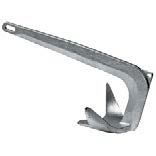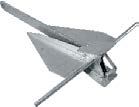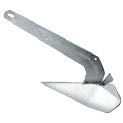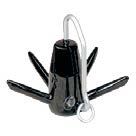The best thing about a pontoon is there is a lot of room. But it’s no surprise the extra room can make these unique crafts more difficult to anchor than your average runabout. The extra floatation that keeps a pontoon more stable in the midst of rougher water, keeps it moving if the anchor isn’t set correctly.
Step One
Head to where you want to anchor, the location will differ based on your needs. Determine the water depth and the nature of the bottom and calculate the amount of rode you will need to release.
The U.S. Coast Guard recommends five to seven times as much line as the depth of the water plus the distance from the surface of the water to the anchor attachment point. Secure your anchor to the cleat at the point of the line where you will want it to stop. From there, point your boat heading into the wind or current, whichever is stronger. Put your engine in idle and bring the pontoon to a stop with the bow just forward of where you want to drop your anchor.
Step Two
Once your boat is stopped, release the anchor slowly into the water. It’s important to remember not to throw it for safety reasons and because the line is more likely to tangle. Because you are pointed into the direction of the wind, your boat should start to drift backward. This allows the anchor to move down and away as it sinks. If your boat is stationary when the anchor hits the ground, the chain will pile on top if it and stop it from digging in. If your boat is not moving on its own, put the engine into reverse and slowly move forward as you release the rode.
Step Three
Remember to keep the tension in the anchor rode. This will keep your boat pointed toward the anchor, which is important because it ensures that your rope and anchor do not tangle. If you’re anchoring in rougher water or stronger winds, you may have to put the engine in forward gear to control the direction and speed of the backward drift.
Step Four
Once you’re in the spot you would like to be in, it’s time to secure the rope so that your anchor will dig in. Wrap the rode twice around a cleat. Once you feel the anchor digging in, put the engine in idle reverse and back down on the anchor to secure it to the bottom. Once it’s set, take note of noticeable landmarks. By checking these points periodically, you can make sure you’re not drifting.
Step Five
Once you’re ready to leave, the anchor should be easy to pull up if it’s been set correctly. Lift the anchor as vertically as possible so it won’t damage your boat. Carefully wash off mud and debris before bringing it into the boat, especially if you are in waters that are known to contain invasive species.
Often times, two anchors are required to keep the boat from drifting. For serious anchoring, using 3 to 4 feet of heavy chain connected directly to the anchor is advised. The length of the chain should be equal to the length of your boat. For a brief stop or for fishing, an all rope anchor rode or shorter chain will be sufficient. The purpose of the chain is to let the anchor to tip over as well as act as a shock absorber, keeping the anchor on its side without letting waves pull on the boat and cause the anchor to rise up and pull loose. Drop the first anchor off the middle of the bow of the pontoon so there will be less resistance to the water and the wind, and less pull on the anchor. Then use the other anchor to keep the boat from swinging if necessary.
Know Your Anchor Types
Anchors come in all shapes and sizes. When deciding which one to purchase, consider the weight of your boat, the average depth of your lake or river, typical wind strength and the bottom condition of the water you will most often boat on. Once you determine what anchor would work best for you, remember to size it to your boat.
 The Claw or Bruce Anchor
The Claw or Bruce Anchor
- Allows for 360 degree turns without releasing from the bottom
- Typically does not break out with wind and tide changes and resets easily
- Easily aligns with the force of the wind
- Dependable setter
- Works well with low scope of rodes
- Boat recommendations: compact pontoons
- Bottom conditions: sand and rock
 The Fluke or Danforth Anchor
The Fluke or Danforth Anchor
- Lightweight
- The two long “flukes” dig into the bottom and bury themselves
- Designed to reset rather than turn
- Large resistance due to flukes digging in
- Very easy to retrieve and store
- High holding power to the weight
- Boat recommendations: most pontoon boats
- Bottom types: sand, clay and mud
 The Plow Anchor
The Plow Anchor
- Anchor has two flukes, but relies on its weight to hold
- Digs right in and holds firmly
- Sets fast and has good resistance to wind movement
- Ideal for use with a remote windlass
- Boat recommendations: best suited for larger pontoons
- Bottom types: designed to hold in a wide-variety of bottom conditions
 The Richter Anchor
The Richter Anchor
- Anchor design that is touted by fisherman
- Aggressive fluke style to hold in a variety of bottom conditions
- Weighted center
- Release bar for easy retrieval, almost 100 percent of the time
- Boat recommendations: suggested for hard-to-hold pontoon boats
- Bottom types: this extremely versatile anchor is designed for a wide-variety of bottom conditions.
 The River Anchor
The River Anchor
- Holds well in fast currents and drift areas, hence the name
- Versatile in hard and weedy/grassy bottoms
- Holds, even in windy conditions
- Boat recommendations: designed for pontoons anchoring in a current area, for example, a river.
- Bottom types: muddy and rocky river bottom conditions

